
Curator
Scalable data pre processing and curation toolkit for LLMs
Stars: 1157
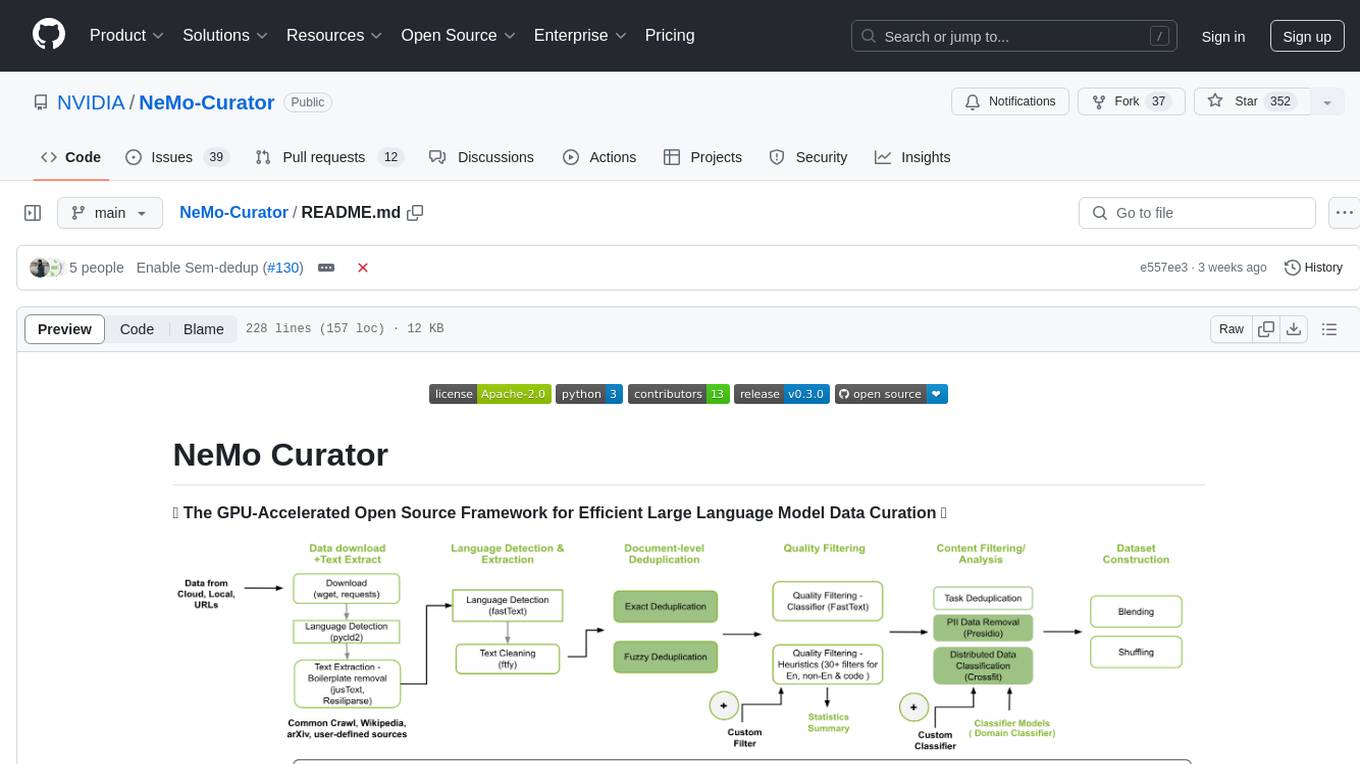
NeMo Curator is a Python library designed for fast and scalable data processing and curation for generative AI use cases. It accelerates data processing by leveraging GPUs with Dask and RAPIDS, providing customizable pipelines for text and image curation. The library offers pre-built pipelines for synthetic data generation, enabling users to train and customize generative AI models such as LLMs, VLMs, and WFMs.
README:
NeMo Curator, part of the NVIDIA NeMo software suite for managing the AI agent lifecycle, is a Python library specifically designed for fast and scalable data processing and curation for generative AI use cases such as foundation language model pretraining, text-to-image model training, domain-adaptive pretraining (DAPT), supervised fine-tuning (SFT) and parameter-efficient fine-tuning (PEFT).
It greatly accelerates data processing and curation by leveraging GPUs with Dask and RAPIDS, resulting in significant time savings. The library provides a customizable and modular interface, simplifying pipeline expansion and accelerating model convergence through the preparation of high-quality tokens.
NeMo Curator also provides pre-built pipelines for synthetic data generation for customization and evaluation of generative AI systems. You can use any OpenAI API compatible model and plug it in NeMo Curator's synthetic data generation pipelines to process and curate high-quality synthetic data for various use cases.
New to NeMo Curator? Start with our quickstart guides for hands-on experience:
- Text Curation Quickstart - Set up your environment and run your first text curation pipeline in under 30 minutes
- Image Curation Quickstart - Learn to curate large-scale image-text datasets for generative model training
For production deployments and advanced configurations, see our Setup & Deployment documentation.
With NeMo Curator, you can process raw data and curate high-quality data for training and customizing generative AI models such as LLMs, VLMs and WFMs. NeMo Curator provides a collection of scalable data processing modules for text and image curation.
All of our text pipelines have great multilingual support. With NeMo Curator, you can pick and choose the features you want and build your data curation pipelines. Text curation follows a three-stage workflow: Load → Process → Generate. A typical pipeline starts by downloading raw data from public resources, then applies cleaning and filtering steps, and optionally generates synthetic data for training enhancement.
- Download and Extraction - Default implementations for Common Crawl, Wikipedia, and ArXiv sources with easy customization for other sources
-
Quality Assessment & Filtering
- Heuristic Filtering - 30+ heuristic filters for punctuation density, length, and repetition analysis
- fastText Classification - Fast language and quality classification
- GPU-Accelerated Classification - Domain, Quality, Safety, Educational Content, Content Type, and Prompt Task/Complexity Classification
-
Deduplication
- Exact Deduplication - Remove identical documents efficiently
- Fuzzy Deduplication - MinHash Locality Sensitive Hashing with optional False Positive Check
- Semantic Deduplication - GPU-accelerated semantic deduplication using RAPIDS cuML, cuDF, and PyTorch
-
Content Processing & Cleaning
- Text Cleaning - Remove improperly decoded Unicode characters, inconsistent line spacing, and excessive URLs
- PII Redaction - Identify and remove personally identifiable information from training datasets
-
Specialized Processing
- Language Identification - Accurate language detection using fastText
- Task Decontamination - Remove potential evaluation data leakage from training datasets
-
Synthetic Data Pipelines - Pre-built pipelines for generating high-quality synthetic training data:
- Open Q&A Generation - Create question-answer pairs for instruction tuning
- Math Problem Generation - Generate mathematical problems for educational content
- Coding Tasks - Create programming challenges and code examples
- Writing Prompts - Generate creative writing and content creation tasks
- Dialogue Generation - Create conversational data for chat models
- Nemotron Pipelines - Wikipedia-style rewriting and knowledge distillation
NeMo Curator provides powerful image curation features to curate high-quality image data for training generative AI models such as LLMs, VLMs, and WFMs. Image curation follows a Load → Process workflow: download datasets in WebDataset format, create embeddings, apply quality filters (NSFW and Aesthetic), and remove duplicates using semantic deduplication.
- WebDataset Loading - Load large-scale image-text datasets in WebDataset format
-
Embeddings & Feature Extraction
- Image Embedding Creation - Generate CLIP embeddings for image analysis
-
Quality Assessment & Filtering
- Aesthetic Classification - Filter images based on aesthetic quality
- NSFW Classification - Remove inappropriate content from datasets
-
Deduplication
- Semantic Deduplication - Remove visually similar images using embedding-based clustering
The modules within NeMo Curator were primarily designed to process and curate high-quality documents at scale. To evaluate the quality of the data, we curated Common Crawl documents and conducted a series of ablation experiments. In these experiments, we trained a 357M-parameter GPT-style model using datasets generated at various stages of our data curation pipeline, which was implemented in NeMo Curator.
The following figure shows that the use of different data curation modules implemented in NeMo Curator led to improved model zero-shot downstream task performance.
NeMo Curator leverages NVIDIA RAPIDS™ libraries like cuDF, cuML, and cuGraph along with Dask to scale workloads across multi-node, multi-GPU environments, significantly reducing data processing time. With NeMo Curator, developers achieve approximately 16× faster fuzzy‑deduplication on an 8 TB RedPajama‑v2 subset, with ~40% lower TCO and near‑linear scaling on 1–4 H100 80 GB nodes. Refer to the chart below to learn more details.
NeMo Curator exhibits near‑linear scaling for fuzzy deduplication. On an 8 TB RedPajama‑v2 subset (~1.78 trillion tokens), processing time drops from 2.05 hours on one H100 80 GB node to 0.50 hours on four nodes. Refer to the scaling chart below to learn more:
We welcome community contributions! Please refer to CONTRIBUTING.md for the process.
For Tasks:
Click tags to check more tools for each tasksFor Jobs:
Alternative AI tools for Curator
Similar Open Source Tools

Curator
NeMo Curator is a Python library designed for fast and scalable data processing and curation for generative AI use cases. It accelerates data processing by leveraging GPUs with Dask and RAPIDS, providing customizable pipelines for text and image curation. The library offers pre-built pipelines for synthetic data generation, enabling users to train and customize generative AI models such as LLMs, VLMs, and WFMs.
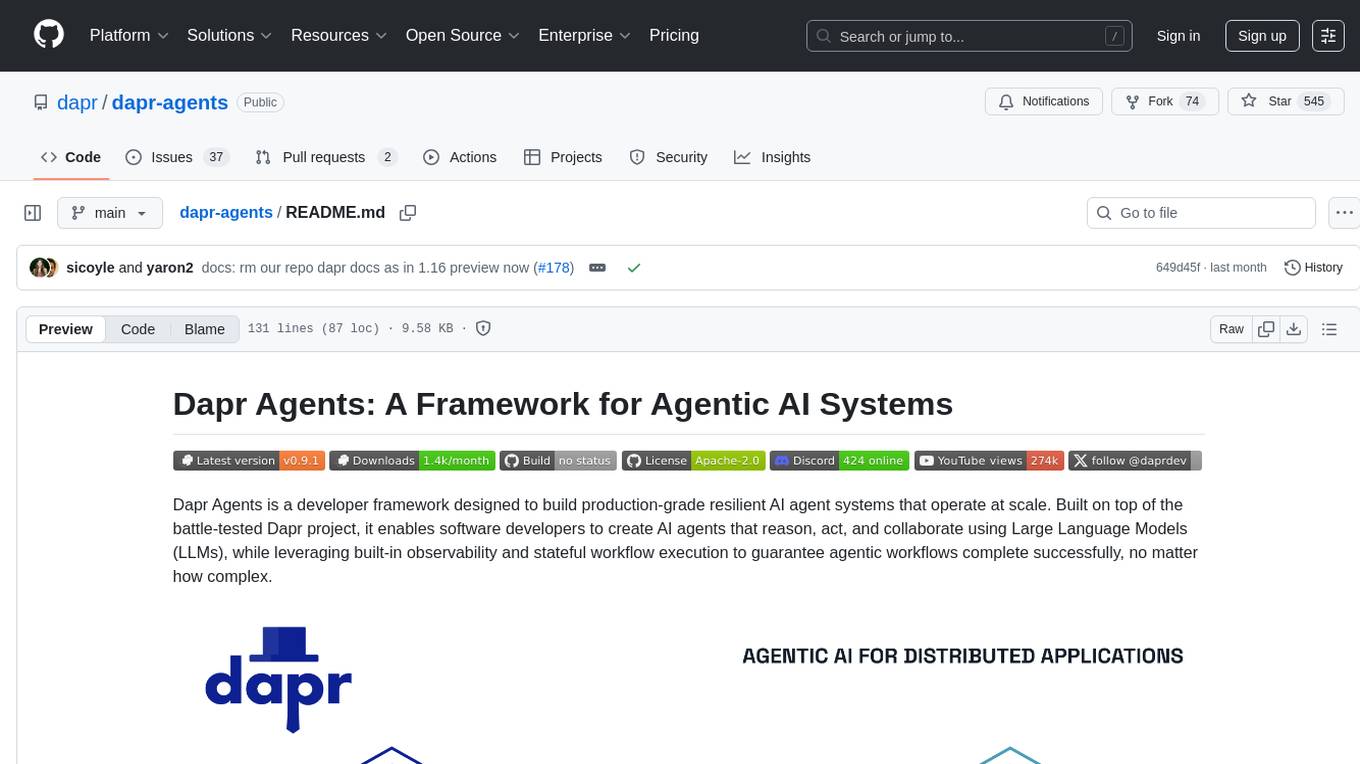
dapr-agents
Dapr Agents is a developer framework for building production-grade resilient AI agent systems that operate at scale. It enables software developers to create AI agents that reason, act, and collaborate using Large Language Models (LLMs), while providing built-in observability and stateful workflow execution to ensure agentic workflows complete successfully. The framework is scalable, efficient, Kubernetes-native, data-driven, secure, observable, vendor-neutral, and open source. It offers features like scalable workflows, cost-effective AI adoption, data-centric AI agents, accelerated development, integrated security and reliability, built-in messaging and state infrastructure, and vendor-neutral and open source support. Dapr Agents is designed to simplify the development of AI applications and workflows by providing a comprehensive API surface and seamless integration with various data sources and services.
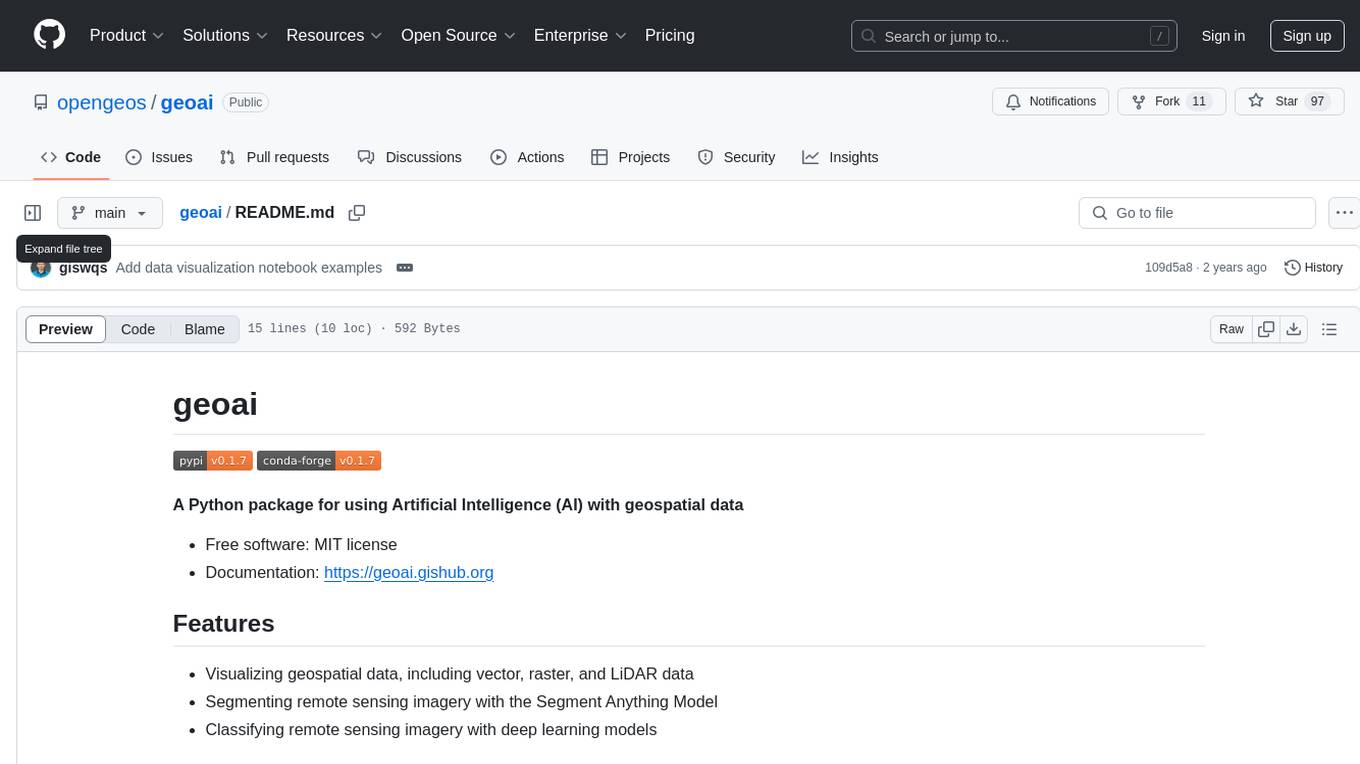
geoai
geoai is a Python package designed for utilizing Artificial Intelligence (AI) in the context of geospatial data. It allows users to visualize various types of geospatial data such as vector, raster, and LiDAR data. Additionally, the package offers functionalities for segmenting remote sensing imagery using the Segment Anything Model and classifying remote sensing imagery with deep learning models. With a focus on geospatial AI applications, geoai provides a versatile tool for processing and analyzing spatial data with the power of AI.
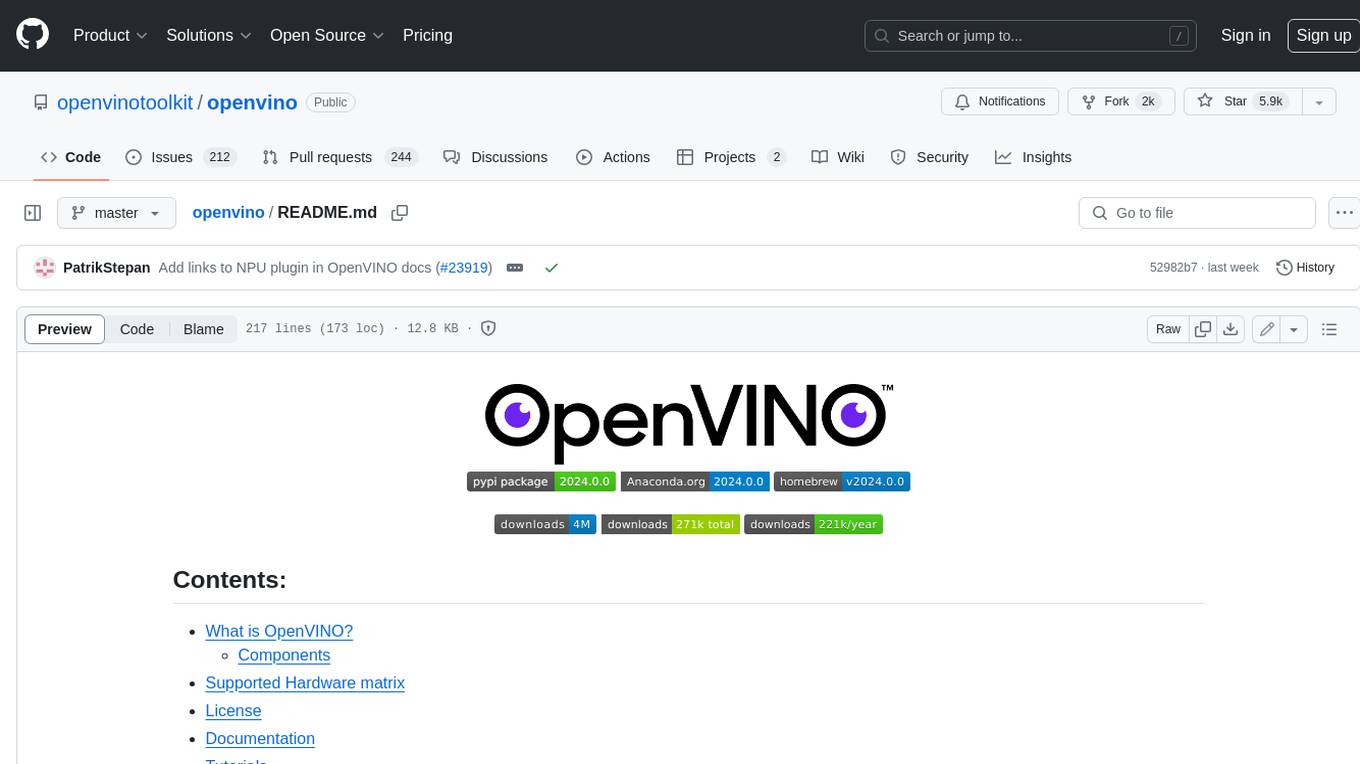
openvino
OpenVINO™ is an open-source toolkit for optimizing and deploying AI inference. It provides a common API to deliver inference solutions on various platforms, including CPU, GPU, NPU, and heterogeneous devices. OpenVINO™ supports pre-trained models from Open Model Zoo and popular frameworks like TensorFlow, PyTorch, and ONNX. Key components of OpenVINO™ include the OpenVINO™ Runtime, plugins for different hardware devices, frontends for reading models from native framework formats, and the OpenVINO Model Converter (OVC) for adjusting models for optimal execution on target devices.
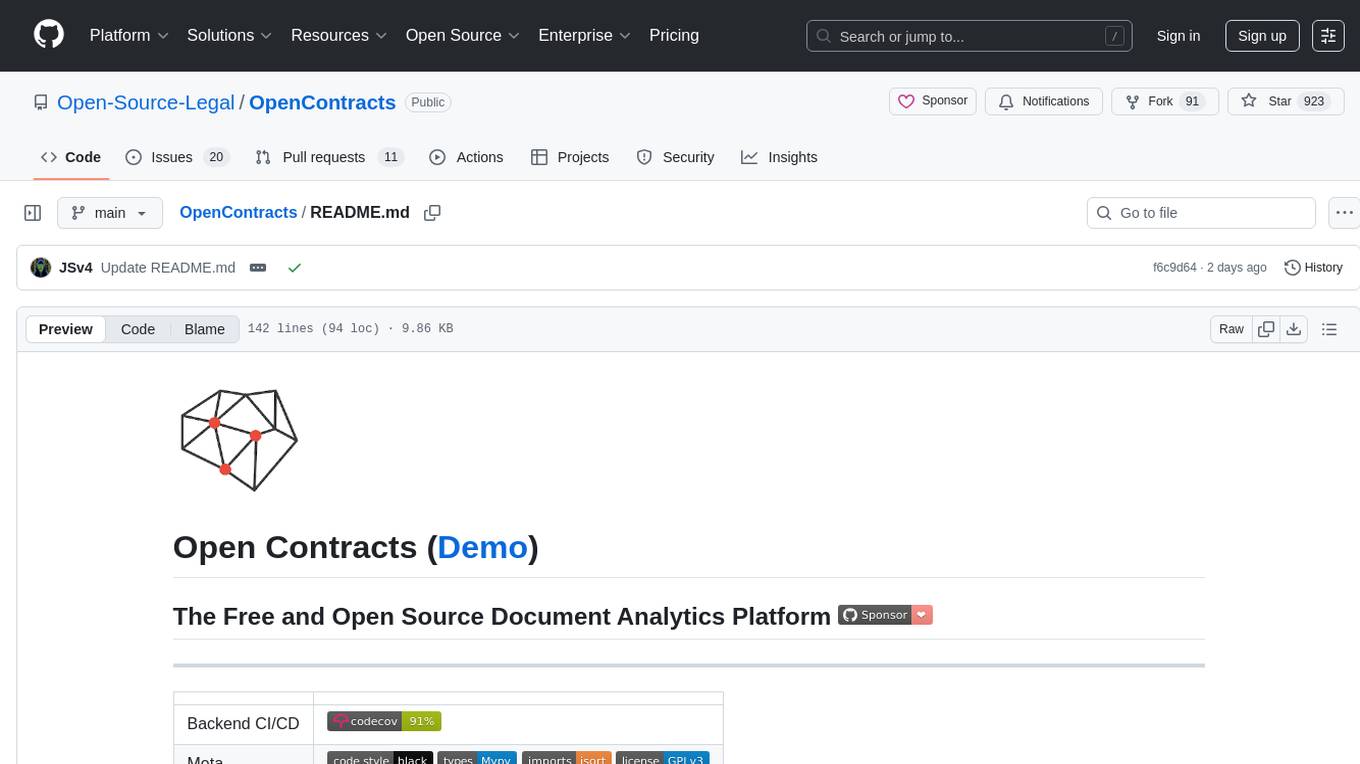
OpenContracts
OpenContracts is a free and open-source document analytics platform designed to empower knowledge owners and subject matter experts. It supports multiple document formats, ingestion pipelines, and custom document analytics tools. Users can manage documents, define metadata schemas, extract layout features, generate vector embeddings, deploy custom analyzers, support new document formats, annotate documents, extract bulk data, and create bespoke data extraction workflows. The tool aims to provide a standardized architecture for analyzing contracts and making data portable, with a focus on PDF and text-based formats. It includes features like document management, layout parsing, pluggable architectures, human annotation interface, and a custom LLM framework for conversation management and real-time streaming.
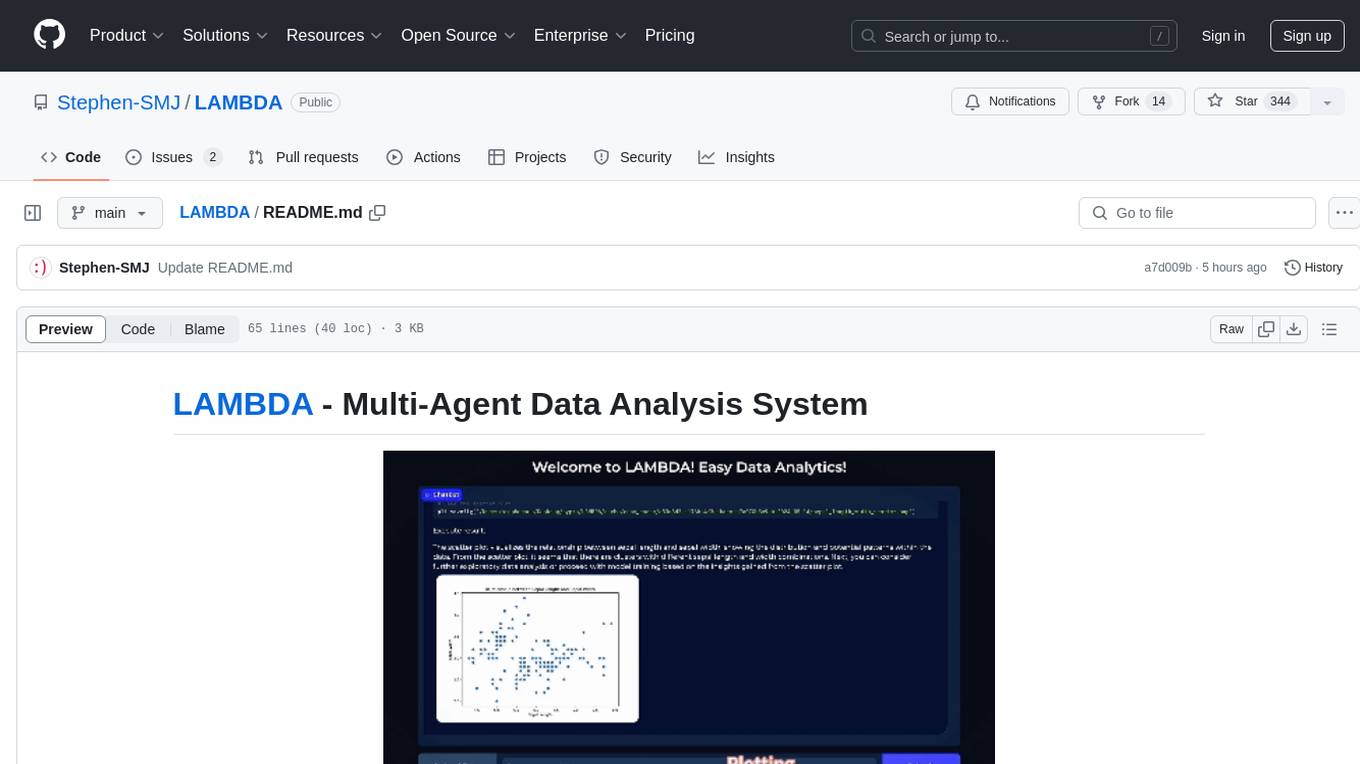
LAMBDA
LAMBDA is a code-free multi-agent data analysis system that utilizes large models to address data analysis challenges in complex data-driven applications. It allows users to perform complex data analysis tasks through human language instruction, seamlessly generate and debug code using two key agent roles, integrate external models and algorithms, and automatically generate reports. The system has demonstrated strong performance on various machine learning datasets, enhancing data science practice by integrating human and artificial intelligence.
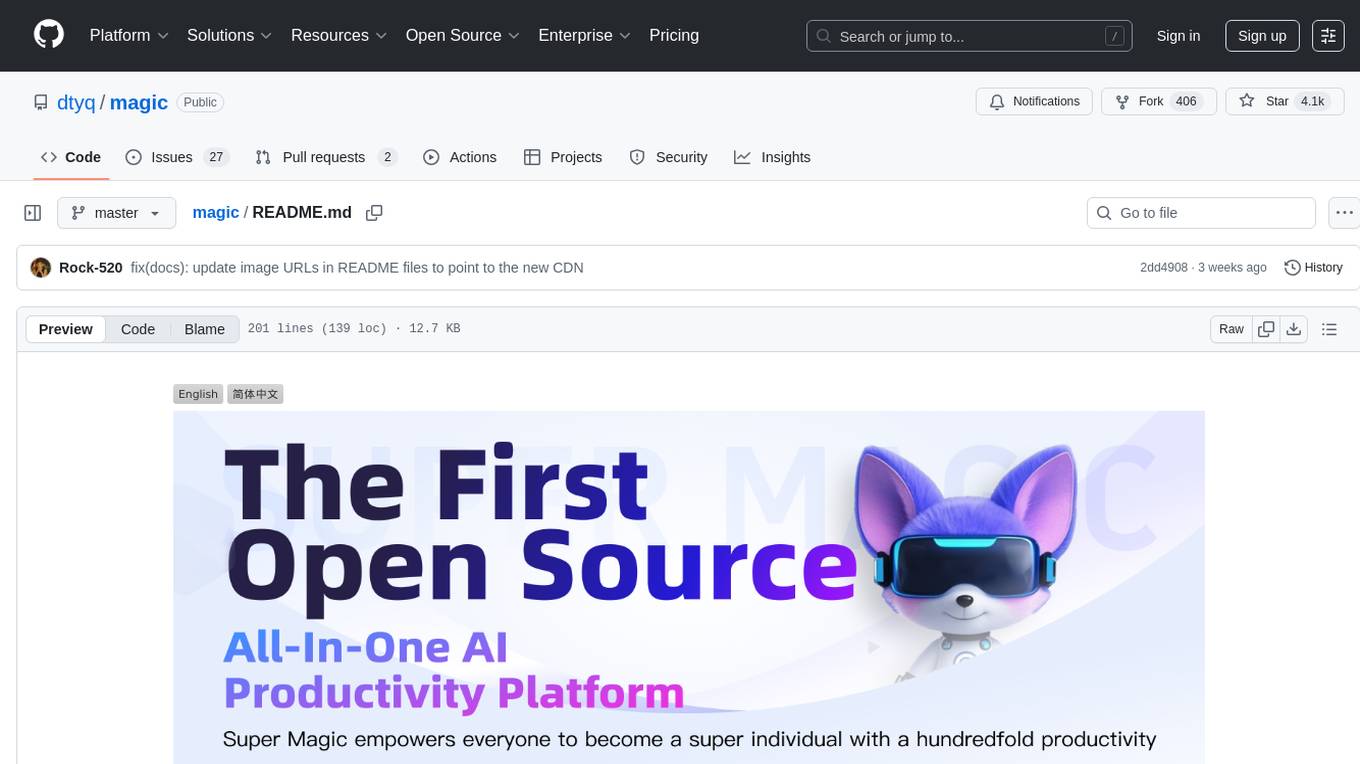
magic
Magic is an open-source all-in-one AI productivity platform designed to help enterprises quickly build and deploy AI applications, aiming for a 100x increase in productivity. It consists of various AI products and infrastructure tools, such as Super Magic, Magic IM, Magic Flow, and more. Super Magic is a general-purpose AI Agent for complex task scenarios, while Magic Flow is a visual AI workflow orchestration system. Magic IM is an enterprise-grade AI Agent conversation system for internal knowledge management. Teamshare OS is a collaborative office platform integrating AI capabilities. The platform provides cloud services, enterprise solutions, and a self-hosted community edition for users to leverage its features.
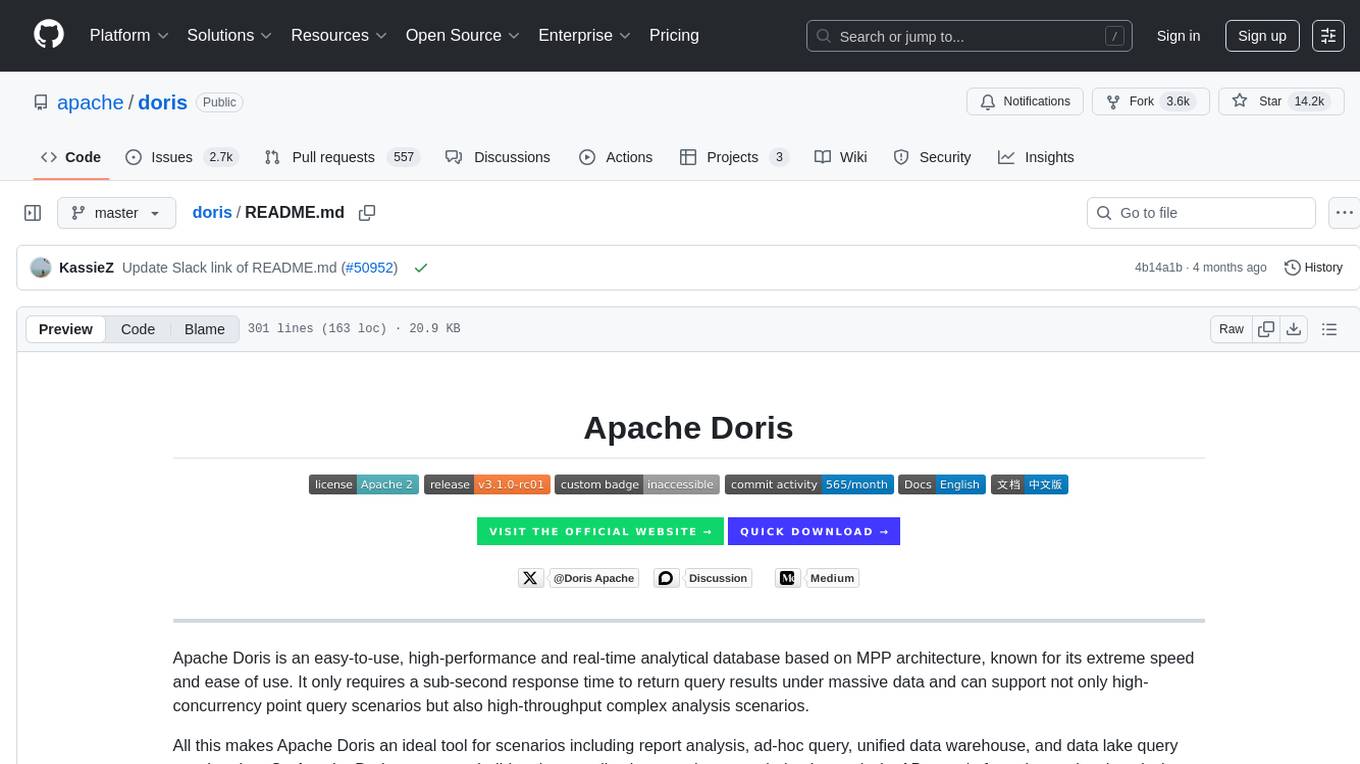
doris
Doris is a lightweight and user-friendly data visualization tool designed for quick and easy exploration of datasets. It provides a simple interface for users to upload their data and generate interactive visualizations without the need for coding. With Doris, users can easily create charts, graphs, and dashboards to analyze and present their data in a visually appealing way. The tool supports various data formats and offers customization options to tailor visualizations to specific needs. Whether you are a data analyst, researcher, or student, Doris simplifies the process of data exploration and presentation.
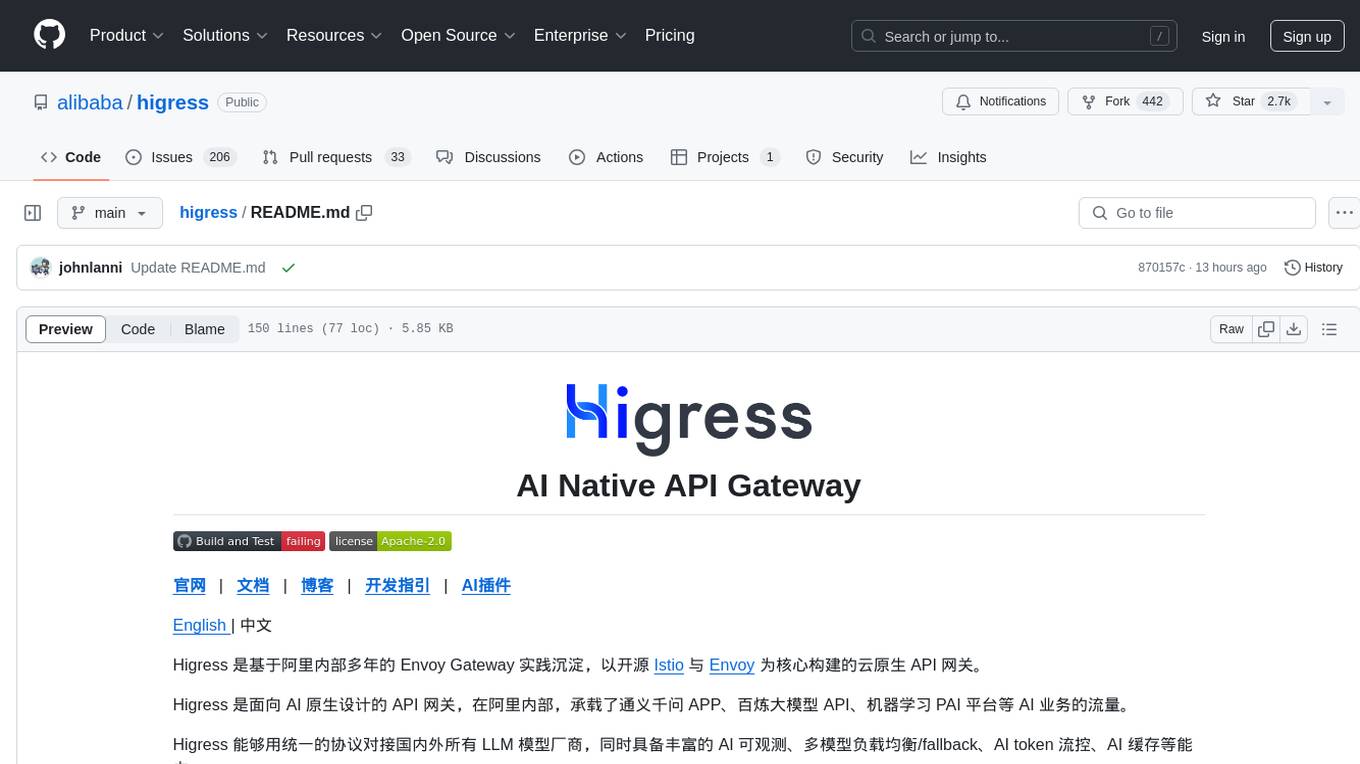
higress
Higress is an open-source cloud-native API gateway built on the core of Istio and Envoy, based on Alibaba's internal practice of Envoy Gateway. It is designed for AI-native API gateway, serving AI businesses such as Tongyi Qianwen APP, Bailian Big Model API, and Machine Learning PAI platform. Higress provides capabilities to interface with LLM model vendors, AI observability, multi-model load balancing/fallback, AI token flow control, and AI caching. It offers features for AI gateway, Kubernetes Ingress gateway, microservices gateway, and security protection gateway, with advantages in production-level scalability, stream processing, extensibility, and ease of use.
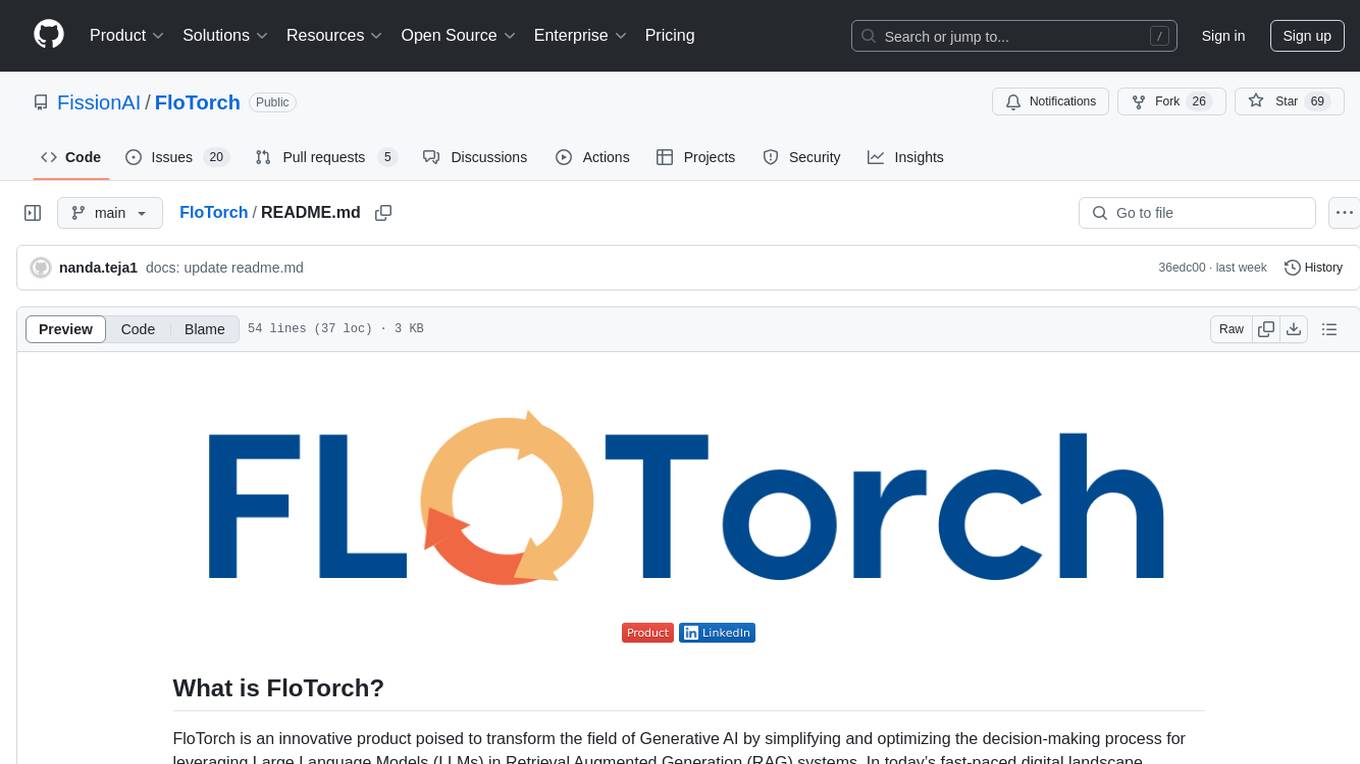
FloTorch
FloTorch is an innovative product designed to simplify and optimize the decision-making process for leveraging Large Language Models (LLMs) in Retrieval Augmented Generation (RAG) systems. It focuses on providing a well-architected framework, maximizing efficiency, eliminating complexity, accelerating selection, and fostering innovation. The tool offers a streamlined, user-friendly approach to help users achieve efficiency, accuracy, and cost-effectiveness in the fast-paced digital landscape of AI.
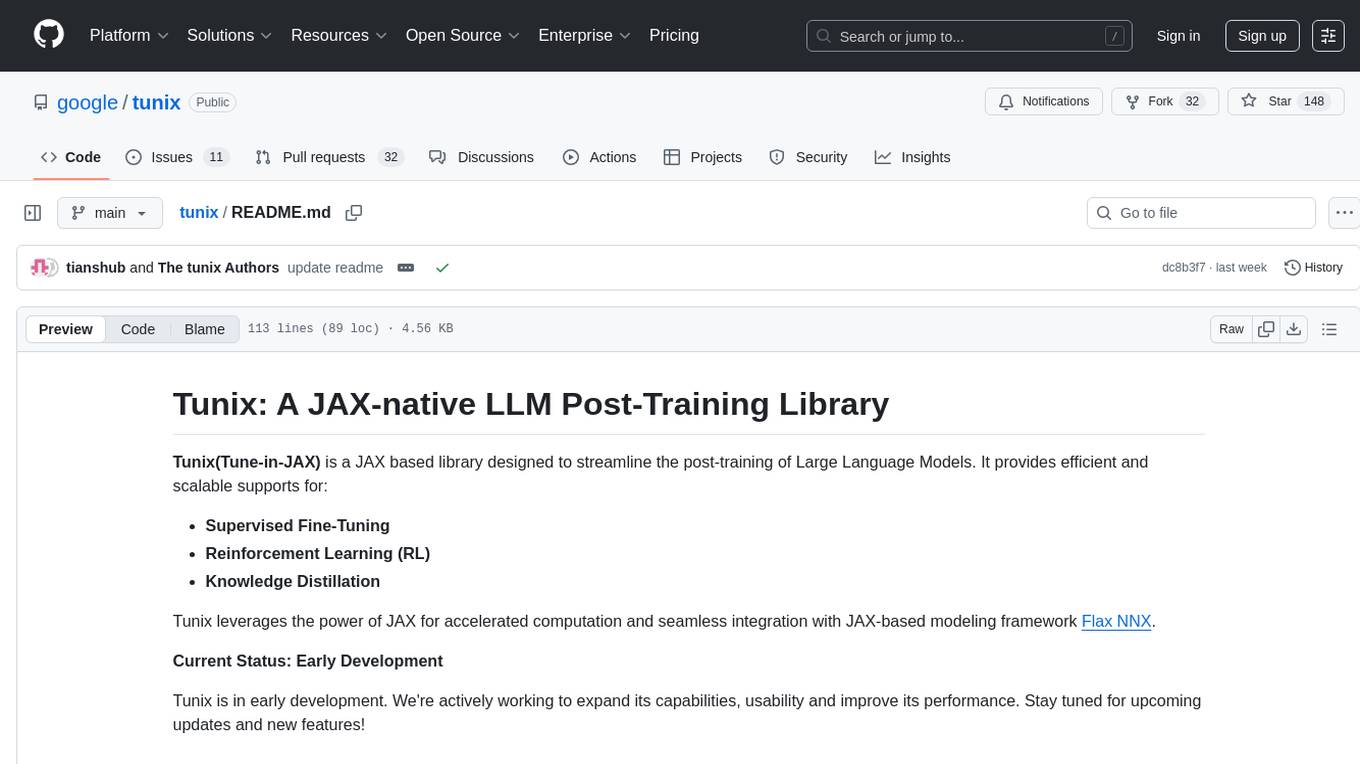
tunix
Tunix is a JAX-based library designed for post-training Large Language Models. It provides efficient support for supervised fine-tuning, reinforcement learning, and knowledge distillation. Tunix leverages JAX for accelerated computation and integrates seamlessly with the Flax NNX modeling framework. The library is modular, efficient, and designed for distributed training on accelerators like TPUs. Currently in early development, Tunix aims to expand its capabilities, usability, and performance.
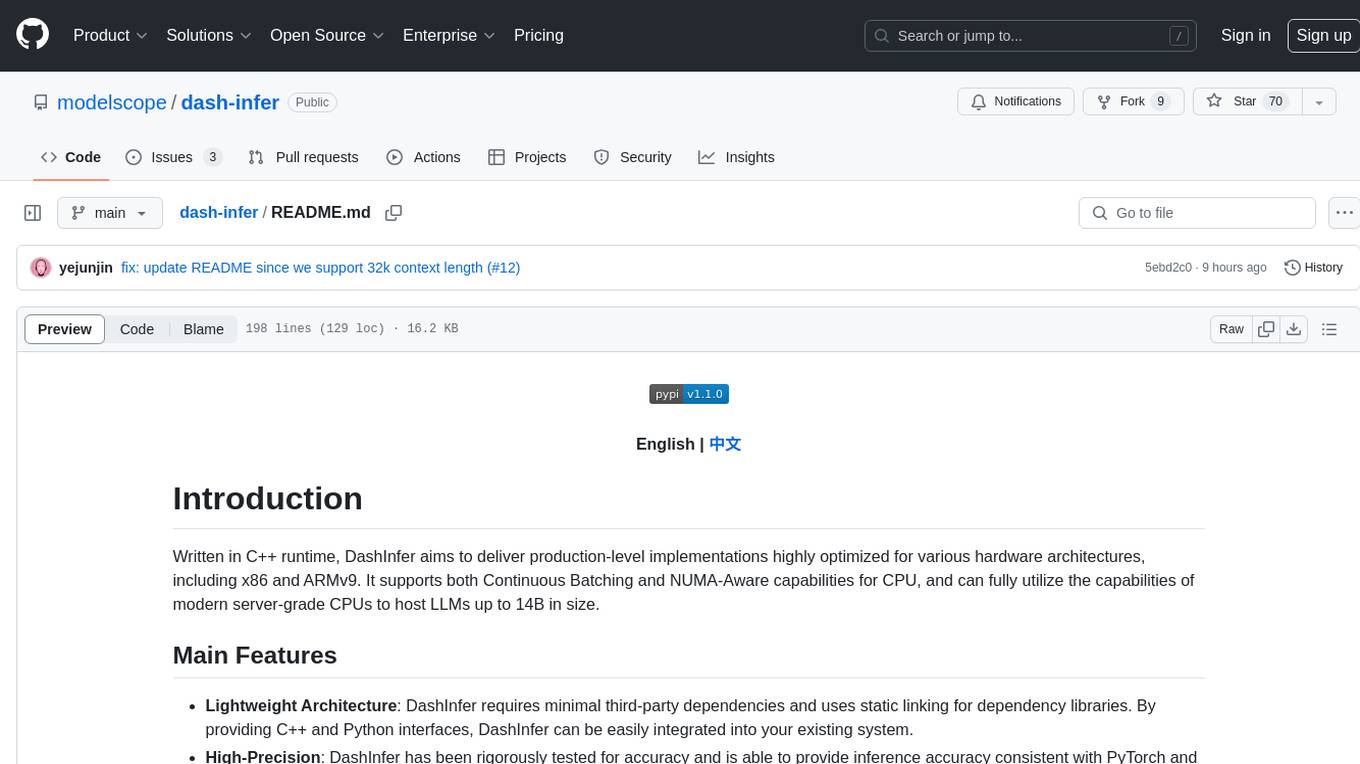
dash-infer
DashInfer is a C++ runtime tool designed to deliver production-level implementations highly optimized for various hardware architectures, including x86 and ARMv9. It supports Continuous Batching and NUMA-Aware capabilities for CPU, and can fully utilize modern server-grade CPUs to host large language models (LLMs) up to 14B in size. With lightweight architecture, high precision, support for mainstream open-source LLMs, post-training quantization, optimized computation kernels, NUMA-aware design, and multi-language API interfaces, DashInfer provides a versatile solution for efficient inference tasks. It supports x86 CPUs with AVX2 instruction set and ARMv9 CPUs with SVE instruction set, along with various data types like FP32, BF16, and InstantQuant. DashInfer also offers single-NUMA and multi-NUMA architectures for model inference, with detailed performance tests and inference accuracy evaluations available. The tool is supported on mainstream Linux server operating systems and provides documentation and examples for easy integration and usage.
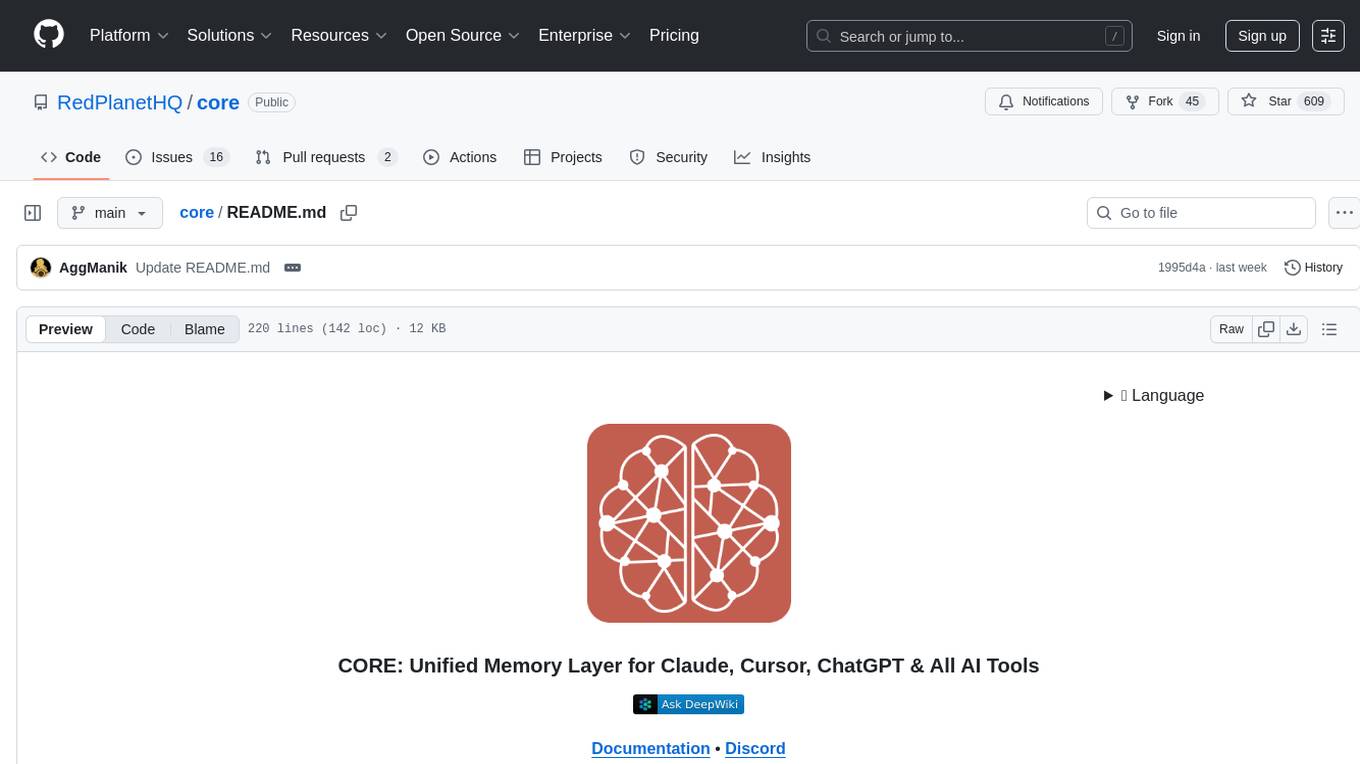
core
CORE is an open-source unified, persistent memory layer for all AI tools, allowing developers to maintain context across different tools like Cursor, ChatGPT, and Claude. It aims to solve the issue of context switching and information loss between sessions by creating a knowledge graph that remembers conversations, decisions, and insights. With features like unified memory, temporal knowledge graph, browser extension, chat with memory, auto-sync from apps, and MCP integration hub, CORE provides a seamless experience for managing and recalling context. The tool's ingestion pipeline captures evolving context through normalization, extraction, resolution, and graph integration, resulting in a dynamic memory that grows and changes with the user. When recalling from memory, CORE utilizes search, re-ranking, filtering, and output to provide relevant and contextual answers. Security measures include data encryption, authentication, access control, and vulnerability reporting.
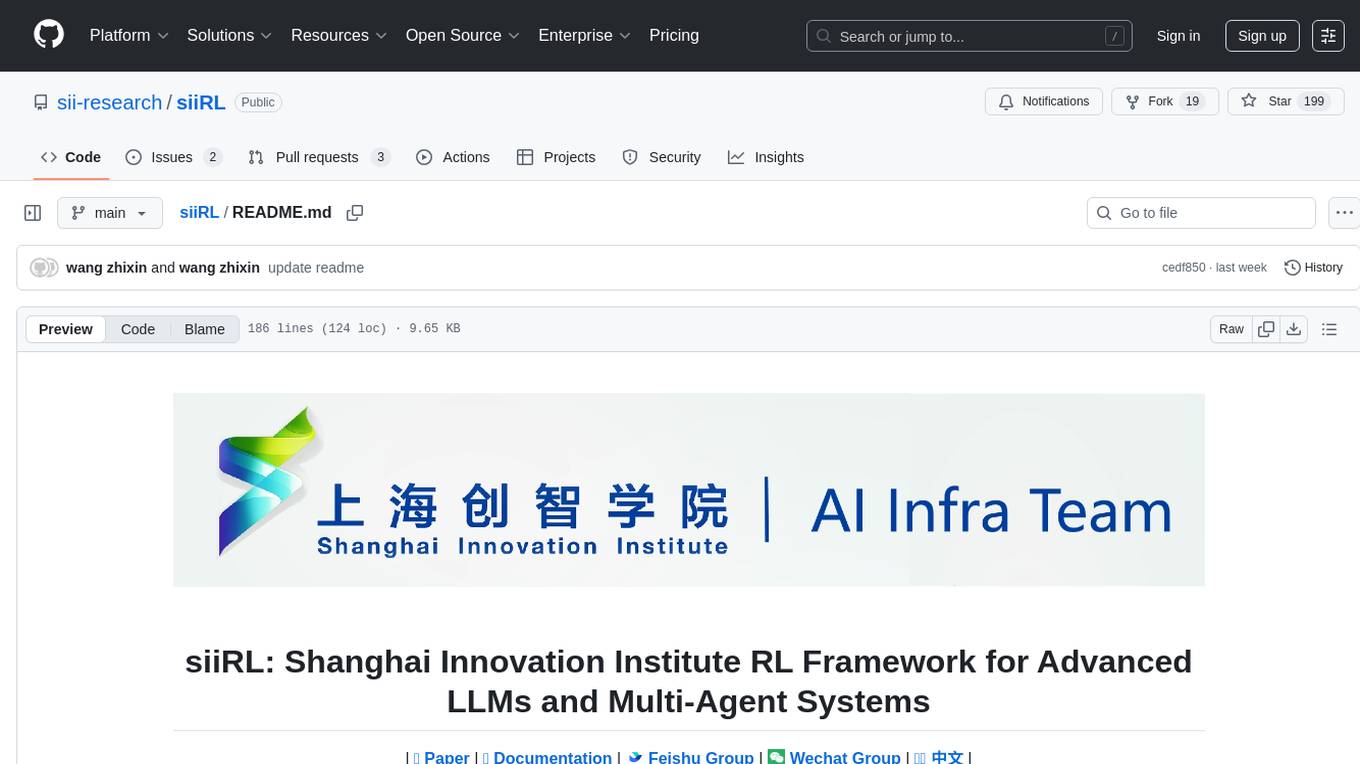
siiRL
siiRL is a novel, fully distributed reinforcement learning (RL) framework designed to break the scaling barriers in Large Language Models (LLMs) post-training. Developed by researchers from Shanghai Innovation Institute, siiRL delivers near-linear scalability, dramatic throughput gains, and unprecedented flexibility for RL-based LLM development. It eliminates the centralized controller common in other frameworks, enabling scalability to thousands of GPUs, achieving state-of-the-art throughput, and supporting cross-hardware compatibility. siiRL is extensively benchmarked and excels in data-intensive workloads such as long-context and multi-modal training.
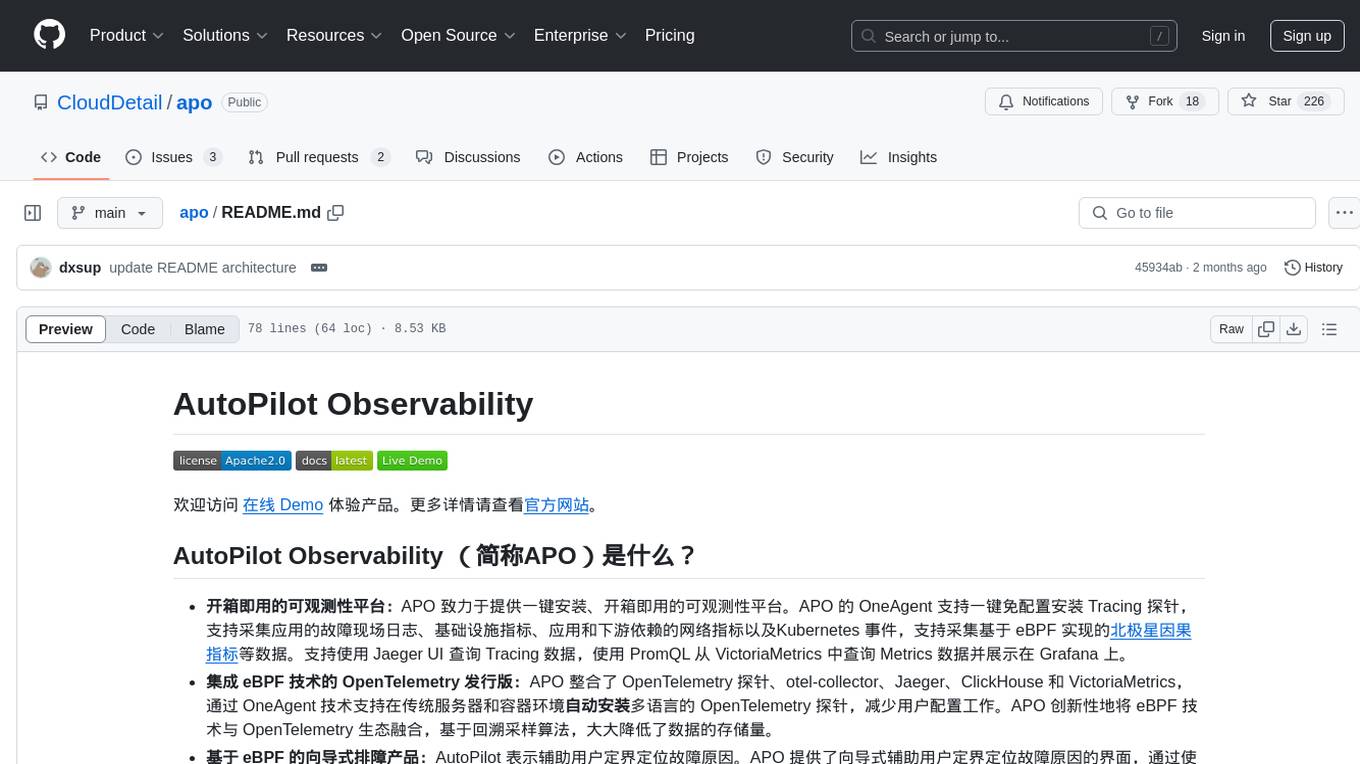
apo
AutoPilot Observability (APO) is an out-of-the-box observability platform that provides one-click installation and ready-to-use capabilities. APO's OneAgent supports one-click configuration-free installation of Tracing probes, collects application fault scene logs, infrastructure metrics, network metrics of applications and downstream dependencies, and Kubernetes events. It supports collecting causality metrics based on eBPF implementation. APO integrates OpenTelemetry probes, otel-collector, Jaeger, ClickHouse, and VictoriaMetrics, reducing user configuration work. APO innovatively integrates eBPF technology with the OpenTelemetry ecosystem, significantly reducing data storage volume. It offers guided troubleshooting using eBPF technology to assist users in pinpointing fault causes on a single page.
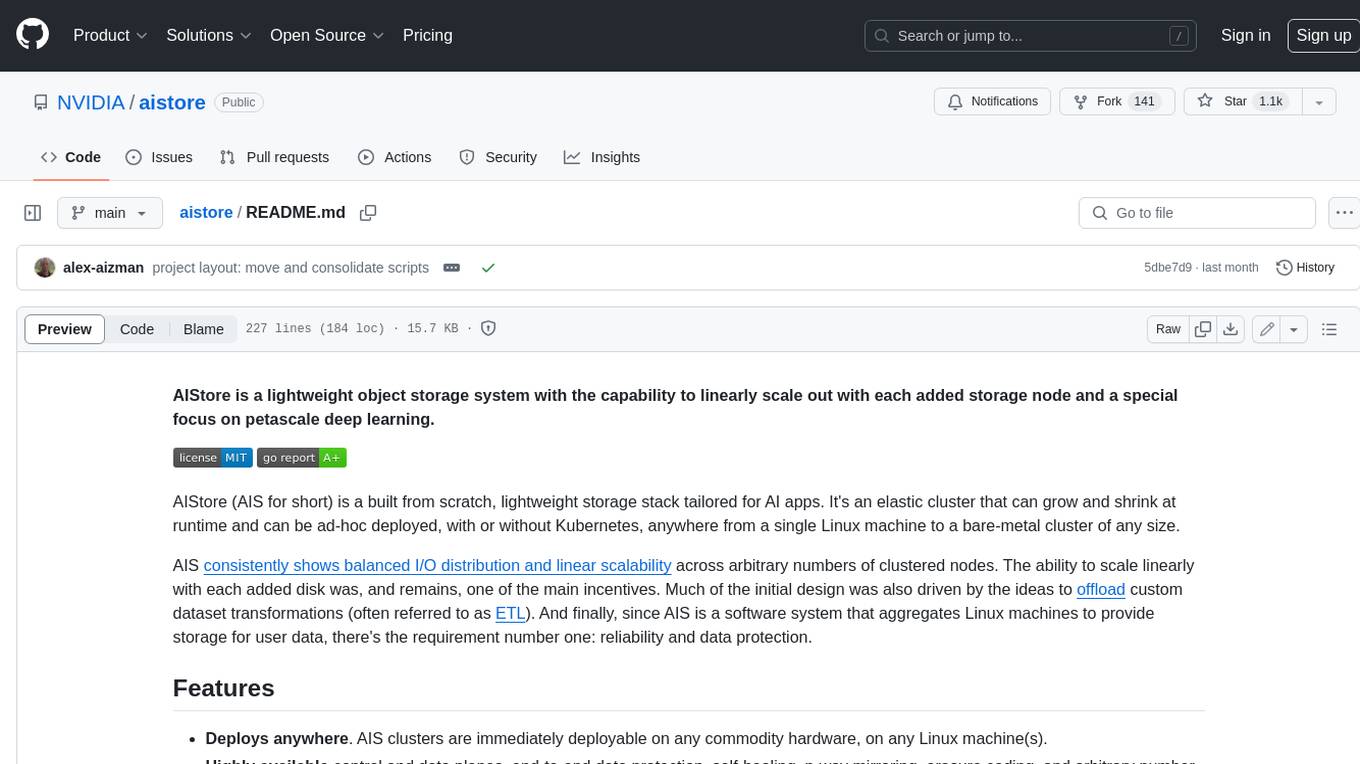
aistore
AIStore is a lightweight object storage system designed for AI applications. It is highly scalable, reliable, and easy to use. AIStore can be deployed on any commodity hardware, and it can be used to store and manage large datasets for deep learning and other AI applications.
For similar tasks

Curator
NeMo Curator is a Python library designed for fast and scalable data processing and curation for generative AI use cases. It accelerates data processing by leveraging GPUs with Dask and RAPIDS, providing customizable pipelines for text and image curation. The library offers pre-built pipelines for synthetic data generation, enabling users to train and customize generative AI models such as LLMs, VLMs, and WFMs.
For similar jobs

weave
Weave is a toolkit for developing Generative AI applications, built by Weights & Biases. With Weave, you can log and debug language model inputs, outputs, and traces; build rigorous, apples-to-apples evaluations for language model use cases; and organize all the information generated across the LLM workflow, from experimentation to evaluations to production. Weave aims to bring rigor, best-practices, and composability to the inherently experimental process of developing Generative AI software, without introducing cognitive overhead.

LLMStack
LLMStack is a no-code platform for building generative AI agents, workflows, and chatbots. It allows users to connect their own data, internal tools, and GPT-powered models without any coding experience. LLMStack can be deployed to the cloud or on-premise and can be accessed via HTTP API or triggered from Slack or Discord.

VisionCraft
The VisionCraft API is a free API for using over 100 different AI models. From images to sound.

kaito
Kaito is an operator that automates the AI/ML inference model deployment in a Kubernetes cluster. It manages large model files using container images, avoids tuning deployment parameters to fit GPU hardware by providing preset configurations, auto-provisions GPU nodes based on model requirements, and hosts large model images in the public Microsoft Container Registry (MCR) if the license allows. Using Kaito, the workflow of onboarding large AI inference models in Kubernetes is largely simplified.

PyRIT
PyRIT is an open access automation framework designed to empower security professionals and ML engineers to red team foundation models and their applications. It automates AI Red Teaming tasks to allow operators to focus on more complicated and time-consuming tasks and can also identify security harms such as misuse (e.g., malware generation, jailbreaking), and privacy harms (e.g., identity theft). The goal is to allow researchers to have a baseline of how well their model and entire inference pipeline is doing against different harm categories and to be able to compare that baseline to future iterations of their model. This allows them to have empirical data on how well their model is doing today, and detect any degradation of performance based on future improvements.

tabby
Tabby is a self-hosted AI coding assistant, offering an open-source and on-premises alternative to GitHub Copilot. It boasts several key features: * Self-contained, with no need for a DBMS or cloud service. * OpenAPI interface, easy to integrate with existing infrastructure (e.g Cloud IDE). * Supports consumer-grade GPUs.

spear
SPEAR (Simulator for Photorealistic Embodied AI Research) is a powerful tool for training embodied agents. It features 300 unique virtual indoor environments with 2,566 unique rooms and 17,234 unique objects that can be manipulated individually. Each environment is designed by a professional artist and features detailed geometry, photorealistic materials, and a unique floor plan and object layout. SPEAR is implemented as Unreal Engine assets and provides an OpenAI Gym interface for interacting with the environments via Python.

Magick
Magick is a groundbreaking visual AIDE (Artificial Intelligence Development Environment) for no-code data pipelines and multimodal agents. Magick can connect to other services and comes with nodes and templates well-suited for intelligent agents, chatbots, complex reasoning systems and realistic characters.






